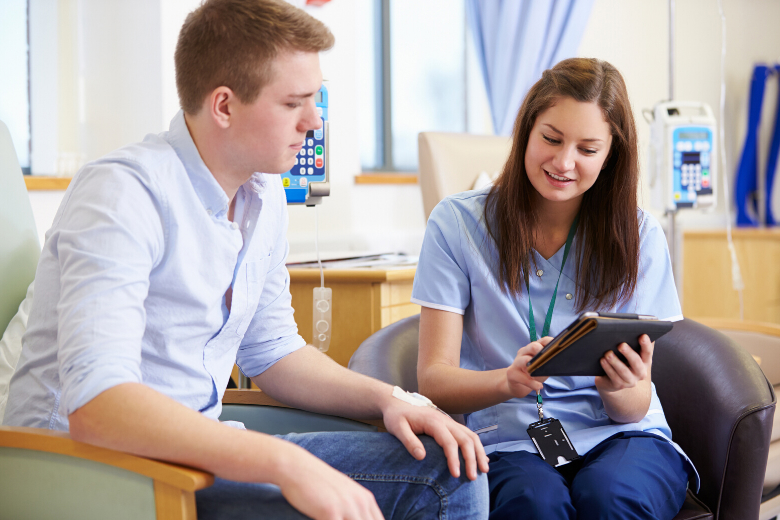Men’s Health and Wellbeing Clinic
A significant driver for the introduction of the Men’s Health and Wellbeing Clinic at Barwon Prison, a high risk and maximum security prison for men, near Geelong in Victoria, was the knowledge that the prevalence of chronic health conditions is higher amongst people in custody compared with the general population. Traditionally, primary health service delivery at Barwon prison was largely reactive and focused on the management of chronic health care needs of the prisoner population.
The establishment of the Men’s Health and Wellbeing Clinic at Barwon Prison, in mid-2016 has made the most of the captive nature of the environment, focusing on health prevention and early detection of chronic disease.
“Generally once prisoners were identified with a chronic health condition, they were booked in for regular health care reviews. That felt a bit to me like the horse had bolted. What we really wanted to do was to identify and get in early for prisoners before they developed a chronic disease.”
Dr Dennis Gonzaga, Medical Officer at Barwon Prison said the clinic encouraged men to look after themselves habitually rather than just responding to a problem.
“It is a good start for the clients to continue to maintain their general health once released from the facility. We have increased detection of chronic health related issues from the clinic and offered management to prevent conditions from getting worse. Plus there are lots of men’s health related issues which have been identified as well – LUTS, sexual function disorders etc. which generally most men don’t want to talk about.”
See how the Men’s Health and Wellbeing Clinic applied the building blocks
See the patient flow through the Men’s Health and Wellbeing Clinic

 A clear plan
A clear plan
Led by Amanda Smith, the Health Service Manager, the original plan was for all prisoners to access the Men’s Health and Wellbeing Clinic. However following a literature review and examination of the Barwon Prison Health Service Occasions of Service and Population Health data, it was identified that the prisoner population group to benefit most from attending the Men’s Health and Wellbeing Clinic were those aged between 35-49 years of age.
Following nomination and selection of the nurse leads to run the clinic, the next step was to develop clearly defined objectives and a framework, including a clinical governance model, communication strategy and how success would be measured.
Once agreed, the key objectives were to target men aged 35-49 years who might not have had contact with the prison health service in the past 12 months.
 Funding
Funding

Prison health services are generally block funded. Generation of income is not dependent upon the Medicare Benefits Scheme’s activity driven (fee for service) model.
Developing a sustainable clinic was dependent upon allocation of resources within existing funding and contracted nursing hours.
 Location and facilities
Location and facilities

The Men’s Health and Wellbeing Clinic operates from a standard consulting room within the Medical Centre at Barwon Prison and offers a range of allied health and specialist health services accessible through the medical clinics’ existing and available resources. In instances where the prisoner is not able to access the medical centre due to their security classification or other operational constraints, nursing staff often negotiate with prison management to bring the Clinic to the prisoner.
The clinic runs once a fortnight and is subject to the challenges of operating in a custodial environment. An incident in the prison can result in the entire facility going into lockdown, which forces cancellation of clinic and sets back the schedule of follow-up appointments.
Nurses generally don’t have a security officer immediately present during consultation but find the prisoners are respectful and appreciate the opportunity to talk to nursing staff and get a new perspective on their health care. If prisoners are not able to see a nurse on the day, arrangements will be made for an appointment to be rescheduled.
 Staffing and HR
Staffing and HR

For the Men’s Health and Wellbeing Clinic to run within current contracted nursing hours, a review of current clinics, service demand and contractual obligations was undertaken. Following this, workflow efficiencies and processes were refined to enable the Men’s Health and Wellbeing Clinic to be undertaken eight hours per fortnight.
To ensure sustainability of the clinic, two nursing staff were selected as clinic leads. The appointment of two staff to this role has enabled backfill for personal and annual leave without interruption to service delivery.
The nurses have built their knowledge and skills in a number of clinical areas to increase their confidence in undertaking the clinic. Education has primarily focused on motivational interviewing, health education and chronic disease management. Opportunities for shared learning such as presentation of case studies and progress updates in the staff meeting have enabled the broader multidisciplinary healthcare team to feel more like active participants rather than just recipients of change. The broader health team is acknowledged for helping support the clinic’s success.
 Best-practice care
Best-practice care

Using validated tools to support the health assessment has assisted the nurses undertaking the Men’s Health and Wellbeing Clinic in identifying areas of risk for the patient. Examples of the validated assessment tools used include, but are not limited to, the Absolute Cardiovascular Disease Risk Assessment Tool, the Australian Type 2 Diabetes Risk Assessment Tool, K10 Mental Health Assessment Tool, and International Prostrate Symptom Score.
For guidelines, the clinic uses the RACGP Guidelines for preventive activities in general practice 9th edition and Men’s Health Toolkit , as well as the Guidelines for the Management of Absolute Cardiovascular Disease risk. In addition, local operating procedures were established to ensure timely follow up by the doctor based on the prisoners identified level of risk. For example prisoners identified as high risk of developing a chronic disease are booked for review by the doctor within 10 business days.
The nurses leads also undertook professional development with an emphasis on health coaching. In this model, nursing staff assume the role of coach rather than that of an expert. Working as a facilitator, the nurse assists the prisoner in identifying their goals and how they may reach them.
 Patient engagement
Patient engagement

Strategies to promote patient engagement have been multi- faceted: Information flyers raising awareness of the clinic were developed and translated into the top five languages spoken within the prison. The flyers were displayed in the prisoner accommodation units and public assembly areas, such as the prisoner canteen and recreation area. Letters of notification were also generated to prisoners aged between 35-49 years, informing them of the purpose of the clinic and advising them of their eligibility to participate.
Promotion of the clinic also included meeting with the Prisoner Representative Group to inform them of the establishment of the Men’s Health and Wellbeing Clinic and to engage their support in promoting the clinic by word of mouth.
Working in partnership with the prisoner and recognising them as the expert and asking what wellness might look like for them has led the prisoner to pursue an active role rather than being a passive recipient in their care.
 Supporting systems and processes
Supporting systems and processes

Whilst the Men’s Health and Wellbeing Clinic operates within the usual systems and processes of the Medical Centre, the day on which the clinic was nominated to be run has needed to be flexible in order to accommodate the broader prison operational needs. Similarly being flexible with appointment times and providing opportunity to see prisoners in their accommodation unit has been important in increasing access for prisoners, particularly those accommodated in a high security unit.
 Evaluation and improvement
Evaluation and improvement

Whilst one of the key areas of focus for the Men’s Health and Wellbeing Clinic was to improve the early detection of chronic disease by targeting male prisoners aged between 35-49 years, prisoner attendance to the clinic was considered the most important measure of success. Men typically present late for diagnosis and management of acute problems. Having prisoners attend the clinic as a preventative activity initially presented as a challenge. Prisoners were reluctant to attend with a view of ‘if its not broken it doesn’t need fixing’. Over time, there has been a gradual rise in the attendance of prisoners to the clinic. This has led to an increased confidence by the nurse leads, that prisoners consider it to be a worthwhile and positive experience.
A number of prisoners have been identified as at high risk of developing chronic disease, namely cardiovascular, diabetes and prostate issues. Men with undiagnosed medical conditions including thyroid, hypertension, diabetes and hepatitis have also been identified.
Ongoing data collection, including review of clinical outcomes and patient satisfaction, continue to be monitored, ensuring the Men’s Health and Wellbeing Clinic is constantly evaluating their progress and approach.
